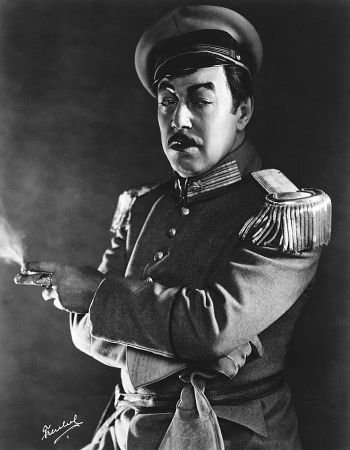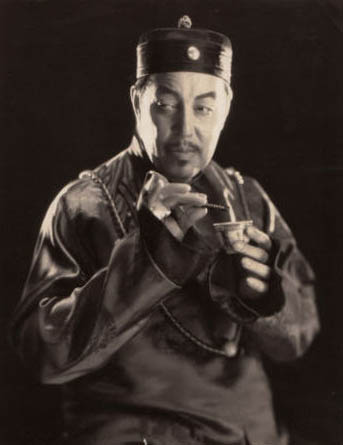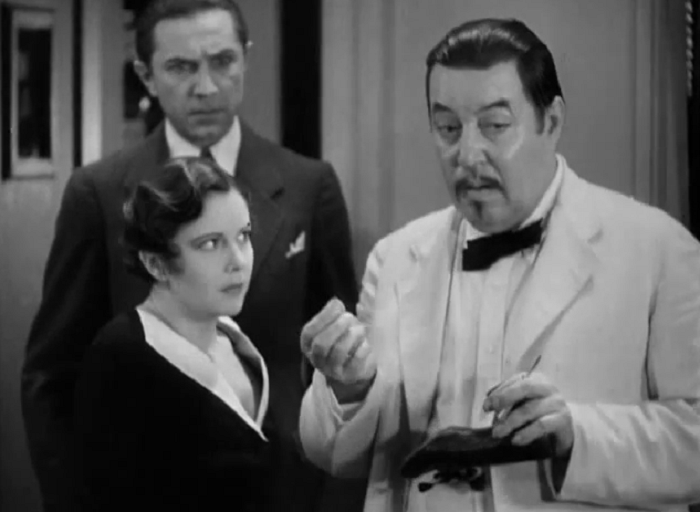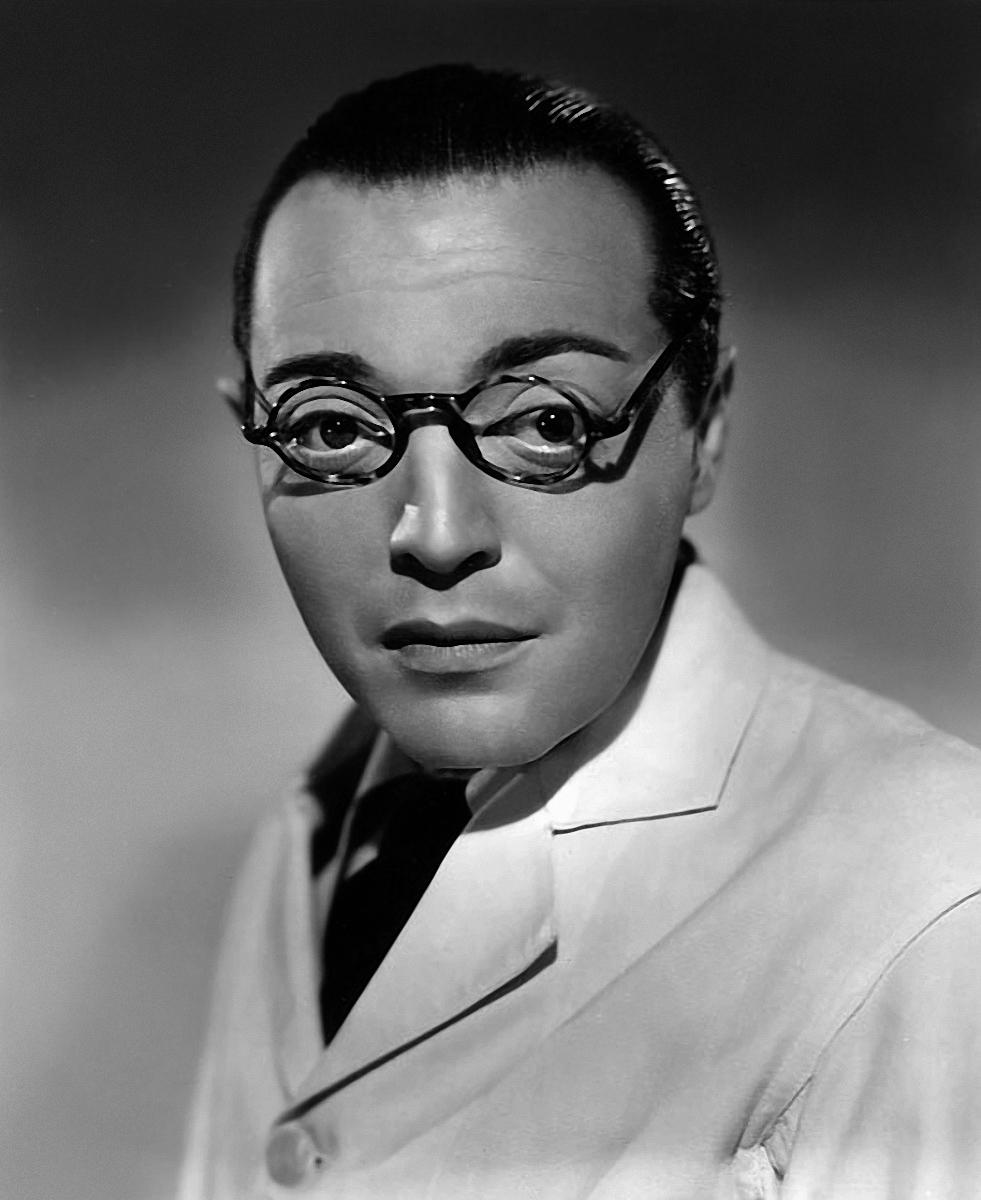On October 3, 1879 in the village of Nyby, Bjurholm Municipality, Vasterbotten County, Sweden, Johan Verner Oland was born. In 1892 when Johan was 13 the family moved to the United States and settled in Boston, Massachusetts were he finished his primary schooling. At some point he started working in the legitimate theater initially in set design, but this led to small acting roles.
In 1906, as an actor, Johan toured the United States with Russian emigre and popular actress Marem-ides Leventon known as Alla Nazimova and her company. His name was now Warner Oland.
A word about Alla Nazimova. The actress is credited with creating the term "Sewing Circle". Today most people think of a group of women meeting to gossip while sewing as a "Sewing Circle". In reality Nazimova used "Sewing Circle" as a "Code" to people she met to cover her being seen with other women. While she carried on Lesbian relationships at a time such action would have cost her career.
In 1907 Oland met and married Edith Gardener Shearn. Editth's birth date is shown as May 12, 1879 on her Social Security Card and other records. In reality she was born May 16, 1872. Edith was both a painter and playwright. In 1912 Warner Oland had his first film role in a two part version of "Pilgrim's Progress".

Through 1938 Warner Oland appeared 97 times on the motion picture screen. I am not going to look at all those motion pictures, but a few select roles he should be remembered for in this short film biography of the actor
Warner Oland claimed to be descended from the Mongol's of Genghis Khan. He said that explained his slightly oriental looks. This claim has been looked into for decades and no connection to the Mongol race can be found in Oland's ancestry.
It has been established that his family was connected to the "Sami" people today known as "Laplanders". Since prehistoric times the "Sami's" have lived in the areas we now call Norway, Sweden, Finland and the Russian Kola Peninsula. The picture below of a group of "Sami's" does show some facial similarities to either the Mongol, or Tartar races. However, the "Sami" genealogy does not tie them to those two other groups as Warner Oland thought.

I bring this up, because of the many oriental roles the actor would play. His first one was the character of "Wu Fang" in the Pearl White motion picture "The Lightning Raider" from 1919. The following still is of Warner Oland in that silent film.

Skipping forward to 1925 found WarnerOland in the Douglas Fairbanks sequel to his very successful "The Mark of Zorro" entitled "Don Q: Son of Zorro". In this production Oland played "The Archduke".The lobby card that follows shows Fairbanks as "Don Q" and to his right Warner Oland.

For those film buffs, like myself, the cast of that picture had three other interesting actors. Prior to 1932's "Red Dust" co-starring Clark Gable and Jean Harlow and of course 1941's "The Maltese Falcon" starring Humphrey Bogart was the leading lady Mary Astor as "Dolores de Muro".
Portraying "Don Sebastian" was British actor Donald Crisp. This was ten years before MGM's "Mutiny on the Bounty" starring Clark Gable and Charles Laughton and such other films as John Ford's "How Green Was My Valley", "National Velvet" and "Lassie Come Home" in which Crisp is known for.
Portraying "Lola" was Lottie Pickford the sister of Douglas Fairbanks' wife Mary
Below Warner Oland without any make-up in 1927. His somewhat oriental features are apparent.

At this time Warner Oland had a major role in the motion picture event that changed the film industry forever: 1927's "The Jazz Singer", In the film with the "Tag Line" "Jolson Talks". Oland portrayed "Cantor Rabinowitz" the father of Al Jolson's character of Jake Rabinowitz, Jake/Jolson becomes "The Jazz Singer" of the title in the first "Talkie" motion picture.
The basically silent motion picture was supposedly to only.have Al Jolson's singing, but the "Vitaphone" recording picked up a few of his spoken lines that were to have been turned into title cards. The rest was motion picture history.

Two years later Warner Oland played a Chinese gangster in 1929's "China Town Nights" based upon a novel called "Tong Wars". Although I do not have a picture of the actor. His character's name was "Boston Charley". The motion picture was originally shot as a silent film, but with the advent of "Talking" pictures the entire production was dubbed and released as "An All Talkie Picture". Of the three stars Wallace Berry, Florence Vidor and Warner Oland. Only Florence Vidor refused to dub her own voice and the wife, at the time, of director King Vidor retired from motion pictures.
On April 10, 1929 Warner Oland appeared in the first of three motion pictures two "Horror Movie" stars would overshadow. The actor became the first sound era version of Sax Rohmer's "Fu Manchu". in "The Mysterious Dr. Fu Manchu".

On May 2, 1930 Oland was back in "The Return of Fu Manchu". The story continues the one started in the first film. Both pictures featured actor O.P. Heggie as Nayland Smith of Scotland Yard. Heggie would be better remembered by fans of Universal Horror movies as the "Blind Hermit" Boris Karloff's Frankenstein Monster befriends in 1935's "The Bride of Frankenstein". Playing the girl in trouble in both movies was Jean Arthur as "Lila Etham", Arthur later were become a major 1930's and 1940's leading lead in such films as Frank Capra's "Mr Deeds Goes to Town" starring Gary Cooper and again opposite Cooper in Cecil B, DeMilles "The Plainsman" as "Calamity Jane" to his "Wild Bill Hickok". Another Capra directed movie classic was the Jimmy Stewart "Mr Smith Goes to Washington".

Below Nayland Smith of Scotland Yard confronts "The Insidious Dr. Fu Manchu".

The third Fu Manchu motion picture was "Daughter of the Dragon", but Heggie and Arthur were not in it. Instead on September 5, 1931 the audiences saw Ann-May Wong as "Ling Moy" the title character.

Ana-May Wong had been in films since 1919 and was the first Chinese-American movie star and continued acting into 1960. To the left on the above poster was Japanese born Sessue Hayakawa. Hayakawa was probably best known to movie goers as the Japanese commandant in 1957's "The Bridge on the River Kwaii". Both Wong and Hatakawa had the extremely rare acceptance of ethnic actors to star in Hollywood motion pictures at the time.
Sax Rohmer's character of Dr Fu Manchu would be played by several other non-Chinese actors. Fu represented the "White Race's" stereo typed image called "The Yellow Peril" of China and the "Chinese Race" in general. This image went back decades before the first Rohmer novel in 1912 appeared. Over the years he would be portrayed by both Boris Karloff , Christopher Lee and even Peter Sellars in a very bad comedy for everyone involved. For those of my readers interested in his history my blog article can be found at:
http://www.bewaretheblog.com/2016/10/boris-karloff-christopher-lee-fu-manchu.html
Prior to "Daughter of the Dragon" Warner Oland was an excellent mad scientist in the horror picture "The Drums of Jeopardy" released March 2, 1931. The forgotten gem can be found as of this writing on the Internet.

I bring this up only because of the name of his character and the controversy that still continues over it. Warner Oland played "Boris Karlov". Note the spelling of the last name.
There are many people who believe it was from this film that William Henry Pratt got the idea to call himself "Boris Karloff". The problem was that Pratt was already using his stage name before this film was released. Some people say no problem! There was the novel released in 1920 that the picture was based upon. However, William Henry Pratt started calling himself Boris Karloff in 1912.
Oland as "Boris Karlov".

I want to skip ahead to 1935, before I discuss Warner Oland's most famous character role.
When a lover of horror movies mentions either Werewolf films in general, or Universal Studio's in particular. The first name most fans will bring up is Lon Chaney, Jr. from 1941's "The Wolfman" and that excellent Jace Pierce make-up. However Lon was not the first werewolf in Universal's stable.
The motion picture was "The Werewolf of London" and it starred Henry Hull as Dr. Glendon. Glendon traveled to Tibet in search of the elusive marihasa plant which blooms only during the full moon. There the doctor is bitten by an animal, or as the movie goers know a werewolf.
Jack Pierce created a simple, but effective make-up for Henry Hull as compared to Lon Chaney, Jr's six years later. However, Hull was not the first Universal Studio's "Wolfman". That honor went to Warner Oland as Dr. Yogami who bites Hull in Tibet and is after the same mariphasa plant to prevent his transformation.
Below the two actors in a publicity still.

Director Stuart Walker wanted to keep Jack Pierce's make-up for the transformation of Henry Hull secret for as long as possible. So unlike the never seen Bela Lugosi as a werewolf in the 1941 movie. The audience sees only the top half and especially the eyes of Warner Oland's werewolf. Which makes the actor the first Universal Studio's character suffering from lycanthropy.

Jack Pierce who created Boris Karloff's "Frankenstein Monster" and "Imhotep" make-ups. Along with other classic's of the 1930's and 1940's found himself unwanted before those years were over by the new studio owners. His story can be found on my blog at:
http://www.bewaretheblog.com/2015/06/jack-p-pierce-man-who-created-monsters.html
Warner Oland as Charlie Chan
Created by writer Earl Derr Biggers and based upon real Chinese/Hawaiian Detective Chang Apana. The character of Chinese/American Detective Charlie Chan first appeared in the 1925 novel "The House Without A Key". One year later Pathe studios turned the novel into a 15 Chapter Serial. Japanese/American actor George Kuwa was the first actor to play the role. The following year Universal Studios turned Bigger's novel "The Chinese Parrot" into a motion picture with Japanese actor Sojin Kamiyama portraying the Detective. George Kuma was also in the picture as Louis Wong.
The Fox Pictures Corporation next turned the 1928 novel "Behind the Curtain" into their 1929 motion picture of the same name featuring Korean actor E.L. Park as Charlie Chan. All three motion pictures minimized the character of the Chinese/American Detective the novels were about. In fact in the 91 minute long "Behind the Curtain".The character of "Police Inspector Charlie Chan" does not appear until the final 10 minutes. To be honest most of these changes could be attributed to the belief in the "Yellow Peril" myth I mentioned above. Which actually was part of the reason the Ohio born, Harvard Educated Earl Derr Biggers created his Chang Apana based character of Charlie Chan. He wanted an obvious counter to Sax Rohmer's "Fu Manchu" for people to read about.
On April 12, 1931 Fox Film Corporation released their second Chan feature "Charlie Chan Carries On". It was based upon the fifth Biggers novel of that same name. The idea that Charlie Chan was meant to be a counter to Fu Manchu was probably missed by Fox's producer Sol M. Wurtzel at the time he cast Warner Oland as Chan. Oland now became the only actor to play both the stereo typical "Yellow Peril" Chinese and his, at least in the novels, reality based opposite. Unfortunately, the motion picture Chan would become more known for his quint fortune cookie like sayings.
Barry Conners and Philip Klein's screenplay restored Charlie Chan as the main character in the story. The story has Charlie attempting to solver the murder of a wealthy American found in a London hotel suite. The story moves from England, to France and Hong Kong to Hawaii. Unfortunately Warner Oland's first appearance in the role is considered a lost film.
As with many films of the time a Spanish language version with a Spanish cast was filmed on the same sets. It is interesting to note that that version entitled "Eran trece (There Were Thirteen)" was written by Conner and Klein also and translated into Spanish. The plot was changed somewhat and scenes designed for Latin audiences added. Additionally the role of Charlie Chan played by Manuel Arbo was secondary to the main stars roles. Arbo had played the Asylum worker in the Spanish version of Universal Studio's "Dracula" the same year.
On June 21, 1931 Warner Oland was back in "The Black Camel" based upon the fourth Chan novel by Earl Derr Biggers. Biggers only wrote Six Charlie Chan books and Five were actually filmed. The sixth "Keeper of the Keys" did become a very short lived Broadway play with William Harrigan as Chan. Harrigan was the brother-in-law of director/playwright Josh Logan. Logan cast him as the original "Captain" in his Broadway play "Mister Roberts" starring Henry Fonda. James Cagney played Harrigan's role in the Logan and Fonda movie version.
"The Black Camel" is interesting because of three of the cast members. Two of them had just appeared in Todd Browning's "Dracula" released four months earlier on February 12th. Having third billing as the "Mystic Adviser Tarneverro" was Dracula himself, Bela Lugosi. One has to wonder how many members of the audience went to see this film, because they had recently seen the Universal Studio's horror release and recognized Lugosi's name?

The other "Dracula" actor was the insane Renfield, Dwight Frye, without screen credit in the small role of Jessup "the Butler". Frye was in two others pictures in 1931. After "Dracula" and prior to "The Black Camel" he had appeared as Wilmer Cook in the forgotten original version of Dashiell Hammett's "The Maltese Falcon" starring Ricardo Cortez as "Sam Spade" and immediately afterwards was seen as Fritz "the Hunchback" in "Frankenstein".

The third actor I want to mention playing one of the love interests is 8th billed Robert Young. This was the third movie for Young and the first he actually had billing. Five years later he felt he was "doomed" to small supporting roles and MGM wanted to drop him. However, the studio loaned Young to Gaumont British for a picture made in England. 1936's "Secret Agent" was directed by Alfred Hitchcock and starred Madeline Carroll (Hitchcock's 1935 "The 39 Steps"), Peter Lorre and the future Sir John Gielgud. Robert Young was billed fourth behind Gielgud. His movie career was launched, but Robert Young still wouldn't be know for films. His claim to fame came from one television program "Father Knows Best". Which ran for 208 episodes from 1954 through 1960 on two networks CBS and NBC.
Below Robert Young in "Father Knows Best"/

Two motion pictures later, including "Daughter of the Dragon", and because of the surprising popularity of the first two Charlies Chan motion pictures. Fox again cast Warner Oland in his third film "Charlie Chan's Chance" released January 24, 1932. This was a remake, of sorts, as it was also based upon Earl Derr Biggers third novel "Behind the Curtain".
Another four films came for the actor between Charlie Chan adventures, but one of those four does deserve mention. It was "The Son-Daughter" released December 23, 1933. It is not necessary to go into this story about San Francisco Chinese raising funds to fight the Mandarin's in their home land, but it is the cast which truly exemplified Hollywood's prejudice to using real ethnic actors in major roles that I want to mention.
Warner Oland played a character named Fen Sha. One of the grand ladies of both the legitimate theater and motion pictures Helen Hayes portrayed one half of the love story Lien Wa. Her character's love interest Tom Lee was played by Mexican-American actor Ramon Navarro. He was best known for the title role in 1925's "Ben Hur". Actor Lewis Stone was cast as Dr. Dong Tong. Stone had appeared in the 1925 classic by stop motion animator Willis O'Brien "The Lost World", but would best be remembered as Judge Hardy in the Mickey Rooney "Andy Hardy" movie series. Actor Ralph Morgan, the older Brother of Frank Morgan of "The Wizard of Oz", known for playing "Heavies" in films was Fang Fou Hy. The final main actor was H.B. Warner who in 1927 portrayed Jesus in Cecil B. DeMille's "King of Kings" and would be nominated for Best Supporting Actor in Frank Capra's classic "Lost Horizon" as the Monk Chang had the role of Sin Kai.
As I said an interesting Chinese (?) cast.
September 15, 1933 saw Warner Oland as Chan once again in "Charlie Chan's Greatest Case" based upon the first of the Earl Derr Biggers series "The House Without A Key". Oland was finding himself cast more in the role of Charlie Chan than in any other character. Two of his next five films where about the Hawaiian based Chinese/American Detective 1934's "Charlie Chan's Courage" and the same years "Charlie Chan in London" featuring pre-Ray Milland, Raymond Milland, and character actor Alan Mowbray. What makes the entry also interesting to my reader is the main writer. This was mystery writer Philip MacDonald who adapted for the screen Daphne Du Maurier's "Rebecca" for Alfred Hitchcock, Robert Lewis Stevenson's "The Body Snatcher" for Val Lewton and his own "The List of Adrian Messenger" for John Huston among other work.
MacDonald would also write 1935's "Charlie Chan in Paris". MacDonald's story was routine, but it introduced the audience to Lee Chan aka: Number One Son. Lee was played by an actor actually born in Guangzhou, China who would be known by his acting name of Keye Luke. Luke would appear in eight motion pictures with Warner Oland. Keye Luke is probably best remembered for playing "Master Poe" in the television series "Kung Fu", but among his voice actor work are three characters in 85 episodes of the English dubbed 1978 anime "Battle of the Planets" and 13 episodes of the original 1983 "Alvin and the Chipmunks".

Also in 1935 the two appeared in "Charlie Chan in Egypt". By this time the screenplays were being made up in an established formula. Between the two Chan films Warner Oland had made "The Werewolf of London" at Universal Studios.
From October 11, 1935 through January 31, 1938 these are the titles of all the motion pictures starring Warner Oland.
"Charlie Chan in Shanghai"
"Charlie Chan's Secret"
"Charlie Chan at the Circus"
"Charlie Chan at the Race Track"
"Charlie Chan at the Opera" featuring Boris Karloff
"Charlie Chan at the Olympics"
"Charlie Chan on Broadway"
"Charlie Chan at Monte Carlo"
In all of the 97 motion picture credits for actor WarnerOland 16 were of the character of Charlie Chan. That amount would have increased, but while filming another episode of the series "Charlie Chan at Ringside". On August 6, 1938 the actor passed away and the screenplay was rewritten with some added scenes to become "Mr. Moto's Gamble" starring German born actor Peter Lorre as novelist John P. Marquand's Japanese/American sleuth. Lorre made eight motion pictures about Mr. Moto and "Mr. Moto's Gamble" was number three.

.jpg)


No comments:
Post a Comment